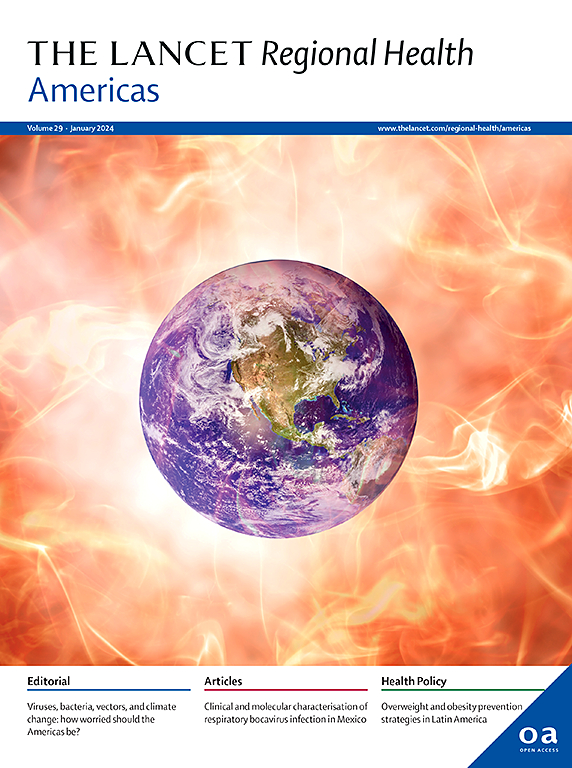巴西住院分娩的地理可及性(2010-2011年和2018-2019年):一项横断面研究
IF 7
Q1 HEALTH CARE SCIENCES & SERVICES
引用次数: 0
摘要
背景:产科护理延误与不良产妇结局有关,而长途分娩与新生儿死亡率高和产妇发病率增加有关。距离和旅行时间是地理上获得保健服务的关键组成部分,也是孕产妇和新生儿护理的重要风险指标。随着时间的推移,本研究评估了巴西统一卫生系统(SUS)在提供医院分娩服务方面是否具有地理可及性。方法:使用SUS医院住院授权的国家汇总数据,对巴西医院分娩的地理可及性进行了为期10年的两个两年期(2010-2011年和2018-2019年)的绘图。估计了妇女居住城市与医院之间的交通流量、距离和时间。研究结果:共分析了6,930,944例医院分娩。总体而言,25.4% (n = 1,759,306)的孕妇前往所在城市以外的单一保健系统医院分娩,从2010-2011年的23.6% (n = 843,501)增加到2018-2019年的27.3% (n = 915,805)。距离和时间分别增加了31.1% (54.0 km-70.8 km)和33.6% (63.1-84.3 min)。经历孕产妇和/或新生儿死亡的妇女跋涉的距离和时间更长。地区差异很明显:东北部女性旅游比例最高(35.6%);n = 817,499),北方最低(16.0%;n = 138,295)。北方女性的旅行距离最长(97.5 ~ 133.4公里),用时最长(1012 ~ 1850分钟),东南部和南部女性的旅行距离最短(37.2 ~ 55.9公里,41.2 ~ 54.8公里),用时最短(38 ~ 52分钟,41 ~ 52分钟)。解释:研究结果突出了单一卫生系统内孕产妇保健服务获取方面的地区差异,这可能会影响孕产妇和新生儿的结局。需要采取有针对性的公共卫生措施,以改善服务的提供,特别是在获得服务的问题最严重的北部和东北部地区。资助:奥斯瓦尔多·克鲁兹基金会;CNPq;FAPERJ。本文章由计算机程序翻译,如有差异,请以英文原文为准。
Geographic accessibility to hospital childbirths in Brazil (2010–2011 and 2018–2019): a cross-sectional study
Background
Delays in obstetric care are associated with adverse maternal outcomes, while long-distance travel for delivery is associated with high neonatal mortality and increased maternal morbidity. Distance and travel time are key components of geographic accessibility to health services and important risk indicators for maternal and neonatal care. This study evaluated whether the Brazilian Unified Health System (SUS) has been geographically accessible in providing hospital childbirth services, over time.
Methods
Geographic accessibility to hospital deliveries in Brazil was mapped over two biennia (2010–2011 and 2018–2019), spanning a 10-year period, using national aggregated data from SUS Hospital Admissions Authorizations. Travel flows, distances, and times between women's municipalities of residence and hospitals were estimated.
Findings
A total of 6,930,944 hospital deliveries were analyzed. Overall, 25.4% (n = 1,759,306) of pregnant women traveled outside their municipalities to give birth in SUS hospitals, increasing from 23.6% (n = 843,501) in 2010–2011 to 27.3% (n = 915,805) in 2018–2019. Distance and travel time rose by 31.1% (54.0 km–70.8 km) and 33.6% (63.1–84.3 min), respectively. Women experiencing maternal and/or neonatal death traveled longer distances and times. Regional disparities were evident: the Northeast had the highest proportion of women traveling (35.6%; n = 817,499), and the North had the lowest (16.0%; n = 138,295). Women in the North faced the longest travel distances (97.5–133.4 km) and times (1,012–1,850 min), while those in the Southeast and South experienced the shortest distances (37.2–55.9 km and 41.2–54.8 km, respectively) and times (38–52 min and 41–52 min).
Interpretation
The results highlight regional disparities in maternal health service access within the SUS, which may affect maternal and neonatal outcomes. Targeted public health measures are needed to improve the availability of service, particularly in the North and Northeast regions, where access issues are most severe.
Funding
Fundação Oswaldo Cruz; CNPq; FAPERJ.
求助全文
通过发布文献求助,成功后即可免费获取论文全文。
去求助
来源期刊

Lancet Regional Health-Americas
Multiple-
CiteScore
8.00
自引率
0.00%
发文量
0
期刊介绍:
The Lancet Regional Health – Americas, an open-access journal, contributes to The Lancet's global initiative by focusing on health-care quality and access in the Americas. It aims to advance clinical practice and health policy in the region, promoting better health outcomes. The journal publishes high-quality original research advocating change or shedding light on clinical practice and health policy. It welcomes submissions on various regional health topics, including infectious diseases, non-communicable diseases, child and adolescent health, maternal and reproductive health, emergency care, health policy, and health equity.
 求助内容:
求助内容: 应助结果提醒方式:
应助结果提醒方式:


